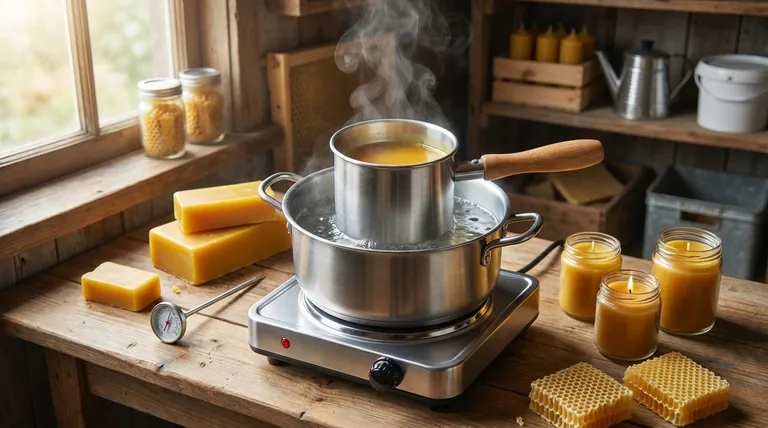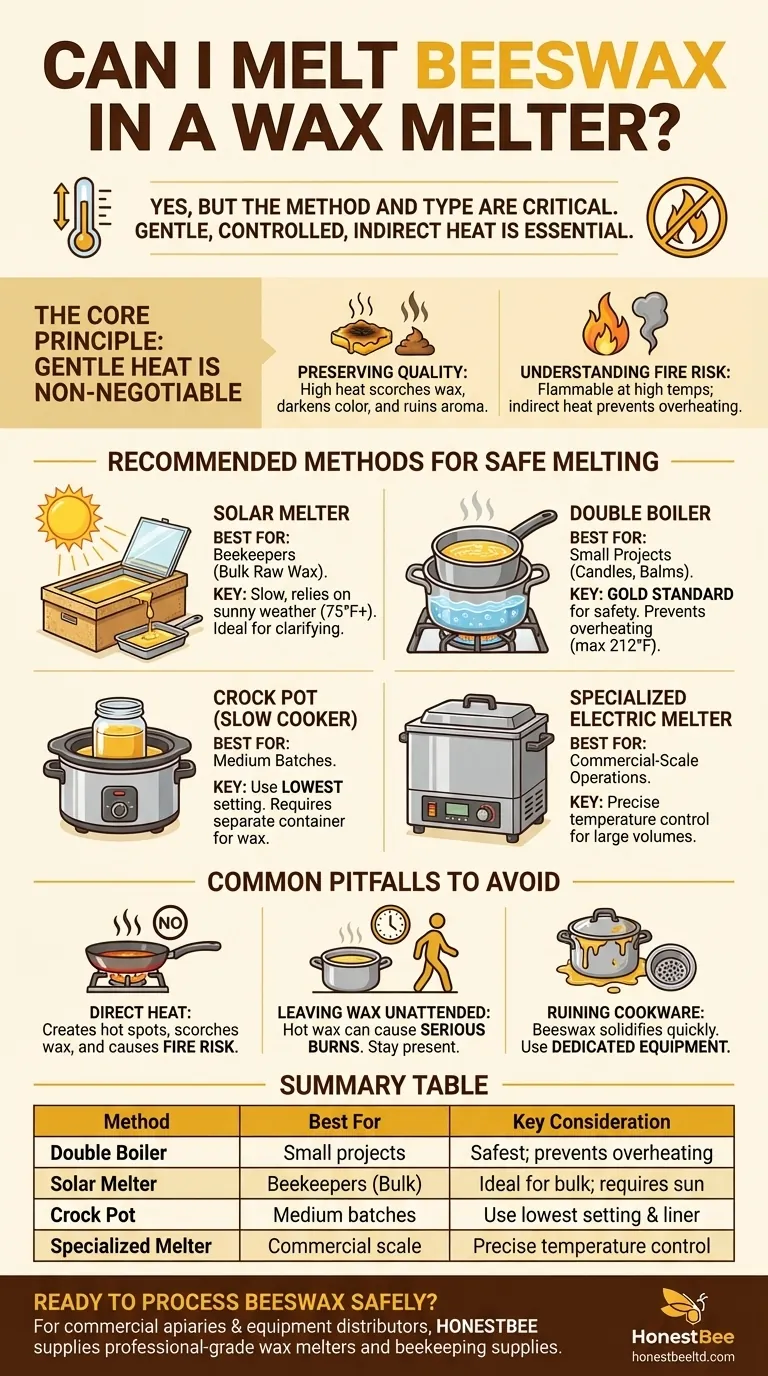Yes, you can melt beeswax in a wax melter, but the method and type of melter are critically important. The defining factor is not the device itself, but its ability to provide gentle, controlled, and indirect heat. Using the wrong equipment or method can scorch the wax, degrading its quality, or even create a fire hazard.
The term "wax melter" can refer to anything from a simple solar oven to a small electric warmer. For pure beeswax, the safest and most effective methods—like a double boiler, a crock pot, or a purpose-built beeswax melter—all share one common principle: they prevent direct, high heat from damaging the wax or reaching its flash point.
What "Wax Melter" Means for Beeswax
The term is broad, and the right choice depends entirely on your goal and the quantity of wax you are working with.
The Solar Melter: For Beekeepers and Bulk Wax
A solar melter is an insulated box with a glass top that uses the sun's energy to gently melt raw wax from honeycombs. The melted wax slowly drips through a filter into a collection pan.
This method is ideal for beekeepers processing large volumes of cappings. It is slow and depends on a sunny, warm day (ideally above 75°F), but it's highly effective for clarifying raw wax.
The Electric Melter: A Question of Temperature
When most people ask about a "wax melter," they are often referring to the small electric warmers used for scented wax tarts. These devices can work, but only if they operate at a very low, consistent temperature.
The primary risk is a lack of temperature control. Many warmers get too hot for beeswax, which can cause it to darken and lose its delicate aroma. Always use a dedicated pot or liner, as beeswax is extremely difficult to clean.
The Core Principle: Why Gentle Heat is Non-Negotiable
Beeswax is a sensitive material that demands careful handling. Aggressive, direct heat is its enemy for two fundamental reasons.
Preserving Quality
High temperatures will scorch beeswax, turning it dark brown and giving it a burnt smell. Gentle heat preserves its natural golden color and sweet, honey-like fragrance.
Understanding the Fire Risk
Beeswax is flammable. If heated too high, it can reach its flash point (around 400°F or 204°C) and ignite. Methods that use indirect heat, like a double boiler, make it virtually impossible to overheat the wax to this dangerous level.
Recommended Methods for Safe Melting
To ensure both safety and quality, professionals and hobbyists alike rely on a few proven methods that provide controlled, indirect heat.
The Double Boiler Method
This is the gold standard for melting beeswax safely. A dedicated pot for the wax is placed inside a larger pot containing simmering water. The water transfers gentle, even heat to the wax, ensuring it never gets hotter than the boiling point of water (212°F or 100°C).
The Crock Pot (Slow Cooker) Method
A crock pot set to its lowest setting can also work well. It is essential to place the beeswax in a separate, smaller container (like a glass jar or tin can) inside the crock pot. Never put the wax directly into the crock pot's ceramic insert unless it will be used exclusively for wax projects.
Specialized Electric Beeswax Melters
For commercial-scale work, beekeepers use large, temperature-controlled electric melters. These units are specifically designed to hold beeswax at a precise temperature for extended periods, making them efficient for large batches.
Common Pitfalls to Avoid
Mistakes when melting beeswax can be messy, wasteful, and dangerous. Avoiding these common errors is key.
Using Direct Heat
Never place a pan of beeswax directly on a stovetop burner. This creates hot spots that will scorch the wax and presents a significant fire risk.
Leaving Wax Unattended
Melted wax is hot and can cause serious burns. Always stay present during the melting process, regardless of the method you choose.
Ruining Your Cookware
Beeswax solidifies quickly and is very difficult to remove from pots, utensils, and drains. It is highly recommended to use dedicated equipment for your wax projects that you do not use for food.
Making the Right Choice for Your Goal
Your approach should be determined by your specific needs and the amount of wax you have.
- If your primary focus is safety and quality for small projects (e.g., candles, balms): Use a dedicated double boiler or the crock pot method for perfect control.
- If your primary focus is processing large amounts of raw honeycomb: A solar melter is the most efficient and traditional tool for the job.
- If you want to use a small electric wax warmer: Test it first with a small amount of wax and monitor it closely, but recognize that a double boiler is the superior and safer option.
By prioritizing controlled, indirect heat, you can safely melt your beeswax while preserving its exceptional natural qualities.

Summary Table:
| Method | Best For | Key Consideration |
|---|---|---|
| Double Boiler | Small projects (candles, balms) | Safest method; prevents overheating |
| Solar Melter | Beekeepers processing raw honeycomb | Ideal for bulk; requires sunny weather |
| Crock Pot (with liner) | Medium batches | Use lowest setting and a separate container |
| Specialized Electric Melter | Commercial-scale operations | Precise temperature control for large volumes |
Ready to process your beeswax safely and efficiently?
For commercial apiaries and beekeeping equipment distributors, having the right equipment is essential for quality and safety. HONESTBEE supplies professional-grade wax melters and other essential beekeeping supplies through our wholesale-focused operations.
Contact HONESTBEE today to discuss your equipment needs and discover how our durable, reliable products can support your beekeeping success.
Visual Guide

Related Products
- Professional Stainless Steel Wax Melter for Beekeeping and Crafts
- Beeswax Melter for Candle Making Honey Bee Wax Melter
- Steam Beeswax Melter Wax Warmer for Wax Processing
- Electric Beeswax Flat Sheet Machine with Operating Tray for Wax Processing
- Honey Wax Separating Wax Press with Metal Screw Wax Separator Machine
People Also Ask
- What are wax melters used for? Unlock Efficient Wax Processing for Your Business
- What is the flash point of beeswax, and why is it important? Essential Safety Guide for Beekeepers
- What temperature range is considered gentle heat for melting beeswax? Preserve Aroma & Color
- How long does the wax melting process typically take? A Guide to Safe & Efficient Melting
- What is the flashpoint of beeswax? Essential Safety and Quality Tips for Beekeepers



















